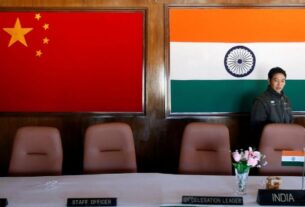New Delhi, April 21 – In a moment filled with warmth, symbolism, and diplomatic promise, US Vice President JD Vance touched down in India today for a four-day visit that could shape the future of trade and strategic cooperation between the two nations.
The visit comes on the heels of Indian Prime Minister Narendra Modi’s recent trip to Washington, where he met with US President Donald Trump to reinforce a growing partnership. This time, it’s Vance’s turn to carry that momentum forward — and he’s brought his whole family along for the journey.
Stepping into New Delhi’s sweltering sunshine, Vance was greeted with a grand red-carpet welcome, complete with an honour guard and vibrant folk dancers. At 40, the vice president is not only a rising political figure but also someone deeply rooted in faith and family — just a day earlier, he met Pope Francis in the Vatican before flying to India.
In one of his first stops, Vance visited the iconic Akshardham Temple, joined by his wife Usha, herself the daughter of Indian immigrants, and their three children — all dressed in beautiful traditional Indian attire. The visit carried both personal and cultural significance for the family, making it more than just a political trip.
Over the next few days, the Vances will travel to Jaipur to see the majestic Amber Fort, and then to Agra to stand in awe of the Taj Mahal — a symbolic gesture of friendship and respect toward India’s heritage.
But the heart of the visit will be the meeting between JD Vance and Prime Minister Modi later today. The two leaders are expected to discuss regional and global issues, review ongoing cooperation, and most importantly, move forward on a long-anticipated trade agreement.
With the US recently pausing steep tariffs under President Trump, India sees a narrow window to seal a deal that could ease economic tensions. “We are very positive that the visit will give a further boost to our bilateral ties,” said foreign ministry spokesperson Randhir Jaiswal last week.
This visit also unfolds against the backdrop of an escalating trade war between the US and China. India, though impacted by tariffs, has approached the situation with cautious optimism — studying both the consequences and potential openings.
President Trump has often spoken highly of Modi, calling him a “great friend” and acknowledging a “special bond” between them. And while trade remains a sticking point, both leaders have expressed a desire for a mutually beneficial agreement that aligns with the growing strategic importance of US-India relations.
In recent years, the two countries have seen an increase in military cooperation and technology trade. India’s booming tech sector depends heavily on the US market, while Washington sees New Delhi as a key player in maintaining regional balance.
Vance’s visit is more than a diplomatic formality — it’s a moment of connection between two democracies navigating a complex global landscape. If all goes well, it may even set the stage for President Trump’s own visit to India later this year for a crucial Quad summit with Japan and Australia.
From temples to trade talks, family ties to foreign policy — this visit is shaping up to be a meaningful step in the evolving US-India relationship.





